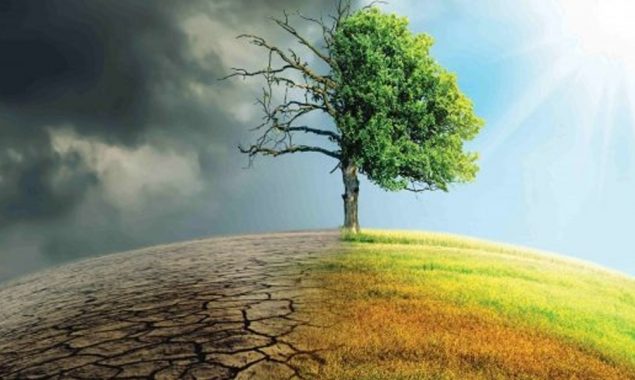
Photo: File
KARACHI: The city of Karachi is likely to experience an alarming rise in temperature, according to the Proceedings of the National Academy of Sciences (PNAS) report.
Even if it establishes a pathway to lower its greenhouse gas emissions, Karachi will witness rising temperatures that are currently categorised as ‘heatwave’. Such extreme weather events that are often associated with a higher mortality risk are likely to become a regular occurrence.
The PNAS report titled Communicating the deadly consequences of global warming for human heat stress stated that even in a global climate held to 2°C above pre-industrial levels, heat-prone megacities like Karachi could expect conditions equivalent to the deadly 2015 heatwave on a yearly basis.
To combat this crisis of insufferable heat, the residents of Karachi on December 13 answered the global call to march for climate action at Nehr-e-Khayyam, Boat Basin area of Clifton.
The citizen-led initiative was backed by multiple local progressive movements including Climate Action Pakistan, the Karachi Bachao Tehreek (KBT), the Indigenous Rights Alliance (IRA), the Awami Workers Party (AWP), the Women’s Democratic Front and the Fisherfolk Forum.
The demonstrators marched in protest against the lack of basic necessities. The collective call for action by climate victims and their allies was supported by social media under the hashtag #ClimateMarchKarachi.
Protecting communities
AWP Karachi general secretary Khurram Ali told Bol News that indigenous communities in the city needed urgent protection. “One of our demands to protect vulnerable communities is rooted in the fact that on one hand, working-class neighbourhoods such as Gujjar Nullah and Orangi Town [nullah] are being demolished, while on the other hand posh areas … [are] allowed to exploit indigenous ecologies.”
He elaborated that such ecologies include the agricultural and natural land of Gadap, Malir and the Khirthar National Park. “On the other side of the city is the coastal belt where builders backed by the government continuously destroyed mangrove forests to pave way for their construction projects. Industries are mushrooming and damaging the green belt and the coastal belt of Karachi. This will turn the city into hell. This should not be happening at all. Malir is the lungs of Karachi.”
Furthermore, the AWP leader said that one of the most important struggles we see today is being led by the IRA and AWP against a number of builders’ megaprojects in the city. “Another one is against the unjust decision of the authorities concerned, under the guise of urban flooding, that has led to the demolishing of the houses of the working-class people near the Gujjar Nullah, Orangi Town and many others, without rehabilitating them. This flooding too was a direct result of the climate crisis and deliberate mismanagement of the successive governments in Sindh.”
In our fight against such injustice, being committed by using the name of climate change, we have realised that this government is absolutely unconcerned about the working class and the natural environment of this city, he shared. “The government including the local administration routinely sidelines the concerns and voices of those who are most affected by Karachi’s climate crisis. We reject such capitalist and neocolonial institutions which have a record of valuing profit and property over the people’s lives.”
The only way to resolve all these crises is by highlighting the struggles and demands of those affected — the indigenous, the displaced and the working class, he concluded.
Historical warming has been strongest in the western areas of Pakistan, according to the Climate Risk Country Profile report by the Asian Development Bank (ADB).
The climate risk profile dataset for Pakistan showed the estimated warming between the periods 1900-1917 and 2000-2017, where 1.3°C of warming took place in the vicinity of the federal capital compared to 0.9°C of warming in and around Karachi.
‘Urban Heat Island’
This research established a reasonably well-constrained relationship between the issue of heat stress and human activities such as workers’ productivity and household consumption patterns. According to the ADB country risk profile, the effects of temperature rises and heat stress in the urban areas are increasingly compounded by the phenomenon of Urban Heat Island (UHI), which has been documented in urban conurbations around the world.
“Dark surfaces, residential and industrial sources of heat, absence of transpiring vegetation and air pollution can push temperatures higher than those of the rural surroundings, commonly anywhere in the range of 0.1°C-3°C in global mega-cities. For instance, night time UHI as high as 13°C has been reported in Karachi,” it read.
The temperature peaks resulting from combined UHI and the climate crisis were impacting human health, the report stated. Moreover, this heat stress coupled with future urban expansion is likely to damage the productivity of the service sector through direct impacts on productivity. There was reportedly also the burden of additional costs of climate adaptation.
Speaking about such structural flaws in the city, Arsalan Anjum, a victim of the Orangi Nullah episode, told Bol News the current capitalist system was based on the market which aimed to ruthlessly exploit the people and the environment. “Slowly but surely the Climate March movement in the metropolis is growing. Different victims of the climate crisis are joining hands. Currently, the movement is facing threats from influential people.”
He added these threats will also grow with the passage of time because the most influential segments of our society as well as some others in different parts of the world are mainly responsible for the crisis. “These powerful elements are not ready to sacrifice their profits to prevent the irreversible damage done to the planet.”
He commented that in Karachi, “eco-fascism” is rooted in the issue of classism. “In the megacity, all the parties as well as the elites built a narrative against the working-class neighbourhoods, claiming that they are responsible for urban flooding. While the fact of the matter is that the megaproject of Lyari Expressway and the lack of a proper and functioning waste and sewerage management system is actually responsible for the floods we see today.”
The activist revealed that more than 100,000 people have been displaced in these demolitions but the government is not even ready to meet the victims.
More and more problems will emerge in Sindh’s capital city, Anjum predicted. “There is a trend to move the working class out of the cities under the guise of environmental preservation whereas in reality, the green belts and coastal belts are sacrificed for construction projects.”
Arif Shah, who serves as the general secretary for the Gujjar Nullah Victims Committee has remarked that people of Gujjar Nullah are the real victims of the environmental disaster. “The residents of the area are not forceful occupiers. The middle-class here leased the houses which are being demolished. Each family here that was deprived of their rightful property must be given their land back and the government should also provide the victims financial assistance.”
He added that so far, no compensatory amount has been given by the government and the other issue of the victims’ ID cards also persists.
“The government is damaging the bastis here in the guise of development and environment protection. If you look at the nullah, the sewerage system is terrible and there are no arrangements at all for cleanliness here. If the [Orangi and Gujjar] nullahs … were cleaned up, the local water problem [would] had been solved and the demolition could have been prevented, and we would have not been protesting on the streets.”
Moreover, he pointed out that the waste water being dumped into the Lyari and Malir rivers ends up in the Arabian Sea, creating high levels of pollution. “The natural environment is being decimated by such industrial pollution as well as the development projects.”
The movement to take action against the climate crisis seeks to end the demolition of Karachi’s working-class settlements and markets as well as to save the vulnerable locals from the impact of heat stress.
Karachi, along with other parts of the country, is one of the most vulnerable to the disastrous effects of the climate crisis. While the contribution of the megacity to global greenhouse emissions remains significantly low, its millions of residents continue to live in the heat-prone region in a constant state of threat.
Moreover, it currently does not have the financial and natural resources to combat the worsening crises compared to its developed counterparts. Communities continue to be impacted disproportionately by the decisions made at government level. This vulnerability of the victims of displacement and poverty is further exacerbated when planning policies prioritise profit over the welfare of the people.
With the damage already done, there is a need to devise policies that preserve the remaining ecology of the city and safeguard the rights of all citizens, particularly those who have already suffered immense losses since the extreme weather conditions started ravaging parts of the city.
Catch all the Pakistan News, Breaking News Event and Latest News Updates on The BOL News
Download The BOL News App to get the Daily News Update & Follow us on Google News.




